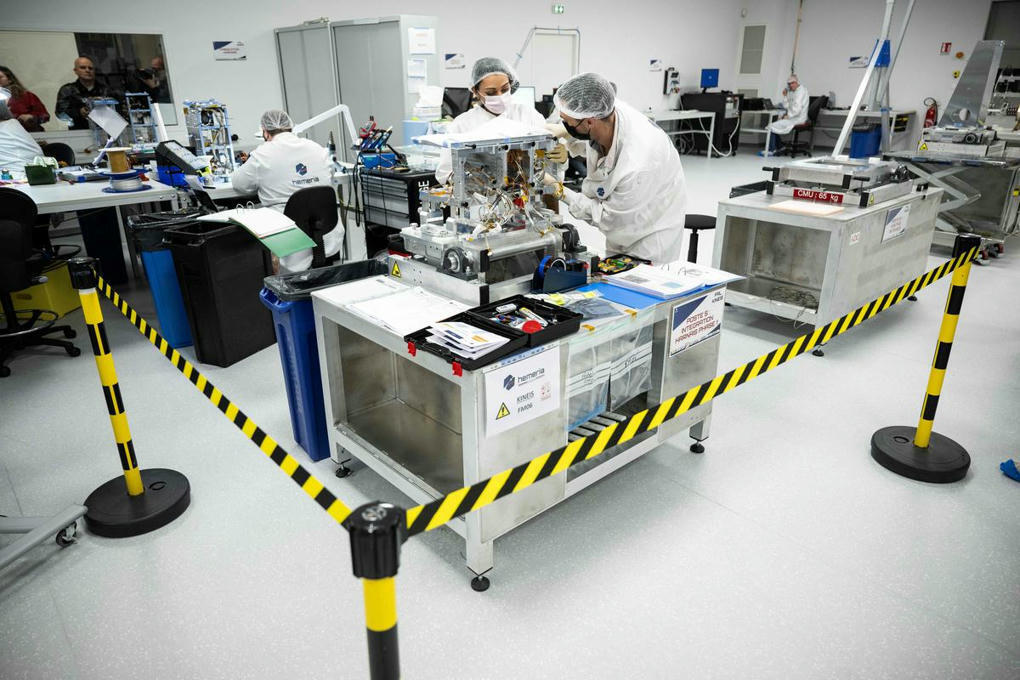
Objets connectés : les Français en retard
www.objetconnecte.com
Oct. 27, 2024, 7:06 p.m.
Les objets connectés s'installent peu à peu dans les foyers français. Selon une enquête menée par reichelt elektronik et OnePoll, 56 % des ménages en France possèdent au moins un appareil intelligent chez eux. Toutefois, les Français affichent un certain retard par rapport à leurs voisins européens. Malgré ces chiffres, les Français restent optimistes quant aux bénéfices des maisons intelligentes, en particulier pour le confort et les économies d'énergie.
Share on

Fin de la 2G et 3G : quelles conséquences pour les objets connectés ? Enjeux et solutions
www.minutenews.fr
Oct. 27, 2024, 7:02 p.m.
L’évolution technologique des réseaux mobiles entraîne des changements majeurs dans notre paysage numérique. L’arrêt programmé des réseaux 2G et 3G soulève de nombreuses questions quant à l’avenir de millions d’objets connectés. Cette transition vers des technologies plus récentes promet des avancées, mais soulève également des inquiétudes concernant l’obsolescence programmée et l’impact environnemental.
Share on

Liste opérateur mobile en France en 2024
www.mezabo.fr
Oct. 23, 2024, 8:53 p.m.
Découvrez l’ensemble des opérateurs mobile présent sur le territoire français. Vous découvrirez également une brève présentation des MVNOs (nouveaux opérateurs virtuels) ainsi qu’un comparatif concernant les performances réseau de chacun. Enfin, vous trouverez un comparatif général concernant les forfaits mobile avec et sans engagement tous opérateurs confondus.
Share on

Objets connectés : les premiers satellites de la constellation française Kinéis sont en orbite
www.sudouest.fr
June 25, 2024, 5:40 a.m.
Les cinq premiers nanosatellites de la constellation Kinéis dédiée aux objets connectés ont été mis jeudi sur orbite avec succès par la petite fusée Electron, six ans après la création de la start-up française. Le minilanceur de Rocket Lab, dont c'était le 50e vol, a comme prévu décollé de son pas de tir en Nouvelle-Zélande jeudi à 6H13 en Nouvelle-Zélande). Un peu plus d'une heure plus tard, les cinq nanosatellites de 30 kg et d'une durée de vie de huit ans étaient déployés à 635 kilomètres d'altitude.
Share on

Internet par satellite : comparatif des abonnements en 2024
selectra.info
June 12, 2024, 6:53 a.m.
Au 12 juin 2024, il est possible d'avoir une connexion internet par satellite dès 34,90€/mois avec l'Offre satellite Neosat Vital. Si votre connexion ADSL est trop lente et n’avez pas encore accès à la fibre, l’Internet par satellite constitue une alternative intéressante pour disposer d’un Internet rapide, quel que soit le lieu de votre domicile ! Découvrez dans notre guide le comparatif des meilleures offres internet satellite !
Share on

Le BCG au chevet de l’opérateur public indien des télécoms
www.consultor.fr
June 5, 2024, 8:07 a.m.
L’opérateur public indien Bharat Sanchar Nigam Limited a confié une mission de près de 15 millions d’euros au BCG pour un plan de relance sur 3 ans. Le syndicat des employés de BSNL y voit un recours « cosmétique » induisant des « dépenses inutiles ».
Share on

FCC Adopts Framework to Allow Satellite-to-Smartphone Coverage in Remote Areas
executivegov.com
March 17, 2024, 10:46 a.m.
The Supplemental Coverage from Space, or SCS, framework authorizes satellite operators to collaborate with terrestrial service providers via lease agreements to operate space stations on certain licensed spectrum allocated to wireless services

Hire your First AI employee: Ava, The Sales Rep Artisan
artisan.co
March 7, 2024, 2:45 p.m.
Ava is the world’s best AI BDR. She takes care of the end-to-end B2B cold email sales process, finding hot leads.

Hype Cycle for eSIM Technology
www.thalesgroup.com
March 7, 2024, 9:51 a.m.
Discover the advantages of eSIM technology, now integral to top tech giants and mobile network operators, offering enhanced standard connectivity for IoT and mobiles. Capitalize on its compactness, seamless profile integration, and increasing popularity, as evidenced in the report "eSIM shipments for 2022 were 382 million with a 13% year over year (YoY) increase as reported by the Trusted Connectivity Alliance (TCA)".

The telco business model is changing: Here’s how
www.novatiq.com
Jan. 30, 2024, 4:39 p.m.
For decades, the telco business model remained relatively unchanged: generating revenue by selling voice and data minutes. Today, however, telcos are moving into vertical business segments and experimenting with new technologies, partnerships, and routes to market. The telecom operating model is evolving in new and unexpected ways as carriers look to unlock new sources of value and win over new customers.
Share on

‘Food Equity Can’t Be a Side Gig’: How Food as Medicine is Becoming A Core Team Capability
medcitynews.com
Jan. 30, 2024, 1:41 p.m.
As the food as medicine movement grows, some payers and healthcare organizations are carving out specific roles and teams dedicated to food and nutrition. Doing so can be beneficial considering the significant impact diet can have on health outcomes.
Share on

JioBharat Phone Captures 45% Market Share In Sub-INR 1,000 Segment Within 5 Months Of Launch
inc42.com
Jan. 20, 2024, 12:34 p.m.
RIL chairman and MD, Mukesh Ambani, attributed the strong uptake of the feature phone as the reason behind Jio’s growing subscriber base. Jio also said that it is in talks with multiple original equipment manufacturers to expand the JioBharat platform further. Reliance Jio announced the launch of a GenAI and LLL-focussed innovation hub in Mumbai in partnership with global telecom alliance, TM Forum
Share on

Samsung intègre l'IA générative en profondeur dans sa série Galaxy S24
www.usine-digitale.fr
Jan. 18, 2024, 11:31 a.m.
L'intelligence artificielle générative arrive dans votre smartphone. Samsung a intégré plusieurs fonctionnalités de traduction, transcription, formatage de texte et retouche photo dans sa nouvelle série Galaxy S24. Des outils à l'intérêt réel pour les pros.
Share on

Agriculture bio : quels débouchés pour sauver la filière ?
www.fnh.org
Jan. 17, 2024, 3:45 p.m.
Activer la demande en restauration hors-domicile, ainsi que la consommation des ménages, des débouchés clés pour sauver l'agriculture bio.
Share on

Smartphones : Transsion, le nouveau venu qui bouscule les géants du marché
www.nticweb.com
Jan. 17, 2024, 12:17 p.m.
Dans le monde en constante évolution de la technologie, l'industrie des smartphones est un domaine où la concurrence est féroce et les tendances changent rapidement. Selon le rapport du cabinet de recherche IDC sur la vente des téléphones mobiles pour le second trimestre 2023, des noms familiers dominent le top 5 du classement, tels que Samsung, Apple, Xiaomi et OPPO. Et parmi ces géants, un nouveau venu, Transsion, est en train de bousculer les cartes en s'imposant dans ce paysage concurrentiel avec une part de marché estimée à 9,5% exæquo avec OPPO. Mais qui est vraiment ce fabricant de smartphones quasiment inconnu du grand public, qui parvient à rivaliser avec les grandes marques ?
Share on

Starlink : l'Internet mobile par satellite est pour cette année !
www.lebigdata.fr
Jan. 9, 2024, 9:25 p.m.
Une couverture totale de l’Internet mobile ? Une utopie diront certains, mais Starlink en a fait une réalité grâce à sa technologie révolutionnaire Direct-To-Cell. La société d’Elon Musk commence à déployer l’infrastructure ad hoc et fournira à terme une couverture quasi mondiale.
Share on

SFR et Orange, opérateurs les plus chers sur mobile et fibre optique : voici le classement complet
www.clubic.com
Jan. 8, 2024, 4:27 p.m.
Dans le prolongement de son étude sur les prix des forfaits mobiles et des abonnements internet à la fibre optique, le comparateur MonPetitForfait a publié l'évolution du tarif mensuel des offres proposées par les opérateurs. Et parmi les plus chers, on retrouve SFR, Orange et sa filiale Nordnet. À l'inverse, RED by SFR, Sosh et les plus confidentiels opérateurs de réseau mobile virtuel (MVNO) comme Auchan Telecom ou NRJ Mobile sont parmi les plus attractifs, coût de la carte SIM et promotions compris. Faisons le point complet.
Share on

Forfaits mobiles : la fidélité ne paie pas
www.capital.fr
Jan. 8, 2024, 4:26 p.m.
Jurer fidélité à un fournisseur de téléphonie mobile n’est pas gage d'avantages. Les nouveaux clients seraient en effet les grands gagnants de leurs offres, selon le comparateur Monpetitforfait.
Share on

SpaceX launches first direct-to-cell satellites aboard Falcon 9
interestingengineering.com
Jan. 3, 2024, 3:06 p.m.
The DTC feature will allow mobile phones to connect directly to the Starlink satellites without ground infrastructure. This will enable users to access voice, text, and data services anywhere, even in remote areas or disaster zones.
Share on

Japan to dispatch solar-powered, flying 5G mobile base station in 2025
interestingengineering.com
Jan. 1, 2024, 12:50 p.m.
Depending on the topography, a ground-based station has a coverage range of 1.8-6.2 miles (3-10 km). A considerable number of base stations are required for large-scale availability of internet services. Since not all countries have the resources to deploy them at China's pace, the roll-out remains slow. The Japanese telecommunication industry is hoping to reestablish its mark once again on the global map by deploying flying base stations in 2025.
Share on